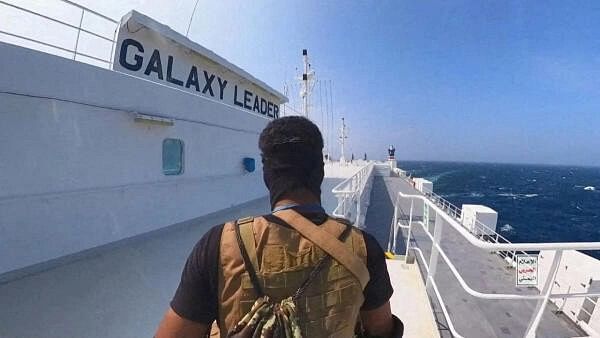
A Houthi fighter stands on the Galaxy Leader cargo ship in the Red Sea in this photo released last month
Credit: Reuters Photo
In a House Armed Services Committee hearing in March 2023 on the US posture and security challenges in the Middle East and Africa, it was acknowledged that “…President Biden’s decision to unilaterally and unconditionally withdraw all US forces from Afghanistan has undermined our national security.” The developments of the past few weeks in the Red Sea have made this assertion seem prophetic.
Yemen’s Houthi rebels have strategically positioned themselves to exploit less monitored zones in the Red Sea and the broader Arabian Sea. With numerous naval vessels navigating this critical route linking the Mediterranean and the Arabian Sea, countering the Houthi rebels and their assaults on global shipping has become exceedingly challenging for the US.
The Houthi rebels have connected these attacks to the ongoing conflict in Gaza, tying the halt in hostilities along shipping lanes to a ceasefire negotiation between Israel and Hamas in Gaza. Their strategy involves increasing attacks on ships and holding them as leverage to prompt the US to pressure Israel for a ceasefire. The timing of the Houthi actions aligns with Israel’s focused operations in southern Gaza and a waning Congressional backing in the US for continuous financial support for overseas conflicts.
Tactically, the Houthis see an opportunity to open a third front in the maritime domain, even as the Israeli air defence systems are overwhelmed by combined rocket attacks of Hamas and Hezbollah in the north and south. In an offensive barrage last week, the Hezbollah carried out six attacks in eight hours. In the maritime domain, the Houthis have carried out multiple UAV, rocket and missile attacks targeting a dozen merchant ships in the larger Indian Ocean. Iran has conducted attacks on US
and Israeli vessels in the region as well.
A recent attack on an Israeli vessel off the west cost of India near Veraval is a red flag for safety and security of the Sea Lines of Communication (SLOC) in the Indo-Pacific. With unmanned aerial vehicles and use of other technological capabilities, the attacks on ships could be rapid, discreet, damaging and, most of all, with little or no accountability.
Often, the vulnerabilities associated with international strategic choke points have always been assessed from the perspective of State complicity, resting States’ conviction on limited capacities of non-State actors to exact huge costs. If anything, the Red Sea crisis shows that even with little but calculated external support, non-State actors could indeed significantly disturb the predictability of global supply chains and bring merchandise flow to a halt. The economic impact of increased attacks in the Red Sea is already being felt, as many ships have begun to avoid the route through the Red Sea and prefer the longer route around the Cape of Good Hope in Africa. This has caused worries of delay in the global freight markets and pricing concerns in energy dependent countries beside the security concerns for shipping companies such as Maersk.
Since the Israel-Hamas war began, the US Central Command has been active in preventing a slew of UAV attacks by the Houthi rebels.
For the US, the situation developing in the Red Sea presents a combination of political, economic and strategic challenges. The ongoing Israeli operation in Gaza has politically isolated the US at the global level as the only country to oppose a UNSC ceasefire resolution. The political heat from the Israel-Hamas war is being felt at home with dwindling youth support for President Biden as presidential elections near. The economic costs of the two wars – one in the Middle East and the other in Ukraine –
is already tearing the US
Congress apart.
At the strategic level, coordinated attacks on international shipping threatens to force a rebalancing of the US force posture in the Indo-Pacific. The US currently has two aircraft carriers positioned in the Middle East since the Israel-Hamas war began. While a strong US military presence in the region may have prevented the war from spreading through the region, any additional and long-time concentration
of force posture in the
Gulf may be detrimental to Washington’s Indo-Pacific intent.
Indeed, America’s Indo-Pacific strategy is being tested in the Middle East through five core ideas. Firstly, the recentring of US forces in the Middle East contradicts the intended pivot towards Asia. Secondly, the attacks orchestrated by the Houthis and Iran highlight the unpredictable threats that can disrupt supply chains in the region. Thirdly, the US faces challenges in executing counterterrorism and counterpiracy efforts in the Indo-Pacific, especially while collaborating with allies. Moreover, integrating the Middle East into an Indo-Pacific connectivity project appears increasingly challenging. Lastly, China’s refusal to join the US in protecting the Red Sea shipping lanes reveals Beijing’s divergent strategy for engaging with the Middle East from that of the US.
(The writer is Fellow, Americas, ORF, New Delhi)